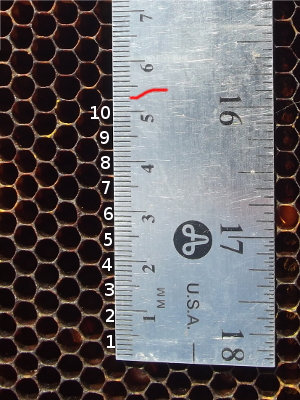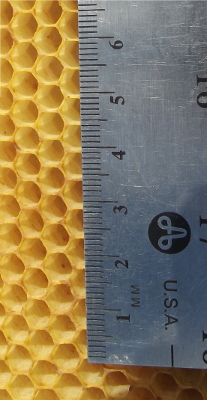
Natural cell size
 Letting bees build
their comb with a natural cell size is one of the tenets of Michael
Bush's organic beekeeping method. I thought I was
following his lead, but I think I skipped a step and didn't actually
manage to downgrade my bees to natural cells. Maybe that's part
of why my hives kept dying.
Letting bees build
their comb with a natural cell size is one of the tenets of Michael
Bush's organic beekeeping method. I thought I was
following his lead, but I think I skipped a step and didn't actually
manage to downgrade my bees to natural cells. Maybe that's part
of why my hives kept dying.
Here's the technical
information:
- Most foundation that beekeepers put in their hives has cells 5.4 mm in diameter.
- Michael Bush (and others) believe that bees naturally build cells ranging in size from 4.6 mm to 5.1 mm for worker brood.
Putting package bees in
a hive with foundationless frames is a good start, but your bees won't
build naturally sized cells right away. Instead, you need to go
through a process called regression where you allow the bees to draw
out the comb and raise bees in it, then cut that wax out and make the
bees draw it again. Workers that have been raised on modern
foundation will generally build 5.1 mm brood cells the first time
they're exposed to foundationless frames, then the smaller bees that
hatch out of that frame will draw 4.9 mm comb.
For easy regression,
keep feeding empty frames into the center of the
brood nest and your bees will eventually turn the outer frames into
honey storage. Then you can just cut out that larger celled wax
as you
harvest honey. (I wonder if it's a coincidence that this is how top bar hives
are often managed?) Making the brood chamber top bars 1.25 inches
wide instead of 1.5
inches wide will also prompt the bees to build smaller
cells.
 I was such a newbie when we
got our first package of bees that I didn't realize I needed to regress
them. As I've been cutting out honey from our dead hives, I
decided to measure the cell size in the brood nest to see what my bees
were actually doing. To measure cell size, lay the centimeter
side of your ruler down on the comb so that 0 lines up with the edge of
one cell, then count ten cells. The number of centimeters that
encompass those ten cells equals the size of one cell in millimeters.
I was such a newbie when we
got our first package of bees that I didn't realize I needed to regress
them. As I've been cutting out honey from our dead hives, I
decided to measure the cell size in the brood nest to see what my bees
were actually doing. To measure cell size, lay the centimeter
side of your ruler down on the comb so that 0 lines up with the edge of
one cell, then count ten cells. The number of centimeters that
encompass those ten cells equals the size of one cell in millimeters.
The photo at the top of
this post shows some old brood comb that probably dates back to the
original package workers. It looks to me like my bees drew 5.2 mm
foundation (once I factor in the way the camera angle offsets the ruler
slightly).
The second photo shows
younger comb that probably got drawn after the meltdown of 2010. It actually looks to
me like this comb is a hair bigger, with cell size of 5.3 mm.
Perhaps that's because the bees were rebuilding during a nectar flow
and were making comb for honey (which is traditionally bigger than comb
for worker brood).
The moral of the story
is --- don't just assume because you're using foundationless frames
that your bees are building at a natural cell size. Bring your
ruler out to the hive and do some quick measurements to see where
you're at, then regress until you achieve 4.9 mm cells.
Want more in-depth information? Browse through our books.
Or explore more posts by date or by subject.
About us: Anna Hess and Mark Hamilton spent over a decade living self-sufficiently in the mountains of Virginia before moving north to start over from scratch in the foothills of Ohio. They've experimented with permaculture, no-till gardening, trailersteading, home-based microbusinesses and much more, writing about their adventures in both blogs and books.
Want to be notified when new comments are posted on this page? Click on the RSS button after you add a comment to subscribe to the comment feed, or simply check the box beside "email replies to me" while writing your comment.
- Remove comment
- Remove comment
